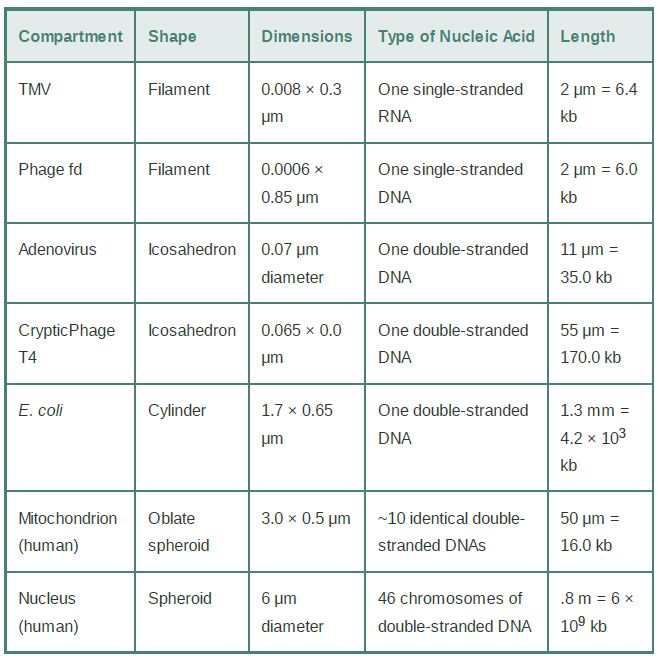


 النبات
النبات
 الحيوان
الحيوان
 الأحياء المجهرية
الأحياء المجهرية
 علم الأمراض
علم الأمراض
 التقانة الإحيائية
التقانة الإحيائية
 التقنية الحيوية المكروبية
التقنية الحيوية المكروبية
 التقنية الحياتية النانوية
التقنية الحياتية النانوية
 علم الأجنة
علم الأجنة
 الأحياء الجزيئي
الأحياء الجزيئي
 علم وظائف الأعضاء
علم وظائف الأعضاء
 الغدد
الغدد
 المضادات الحيوية
المضادات الحيوية|
Read More
Date: 7-12-2015
Date: 10-3-2021
Date: 6-12-2015
|
Introduction to the Chromosomes
A general principle is evident in the organization of all cellular genetic material. It exists as a compact mass that is confined to a limited volume, and its various activities, such as replication and transcription, must be accomplished within this space. The organization of this material must accommodate local transitions between inactive and active states.
The condensed state of nucleic acid results from its binding to basic proteins. The positive charges of these proteins neutralize the negative charges of the nucleic acid. The structure of the nucleoprotein complex is determined by the interactions of the proteins with the DNA (or RNA).
A common problem is presented by the packaging of DNA into phages, viruses, bacterial cells, and eukaryotic nuclei. The length of the DNA as an extended molecule would vastly exceed the dimensions of the compartment that contains it. The DNA (or in the case of some viruses, the RNA) must be compressed exceedingly tightly to fit into the space available. Thus, in contrast with the customary picture of DNA as an extended double helix, structural deformation of DNA to bend or fold it into a more compact form is the rule rather than the exception.
The magnitude of the discrepancy between the length of the nucleic acid and the size of its compartment is evident in the examples summarized in TABLE .1. For bacteriophages and eukaryotic viruses, the nucleic acid genome, whether single-stranded or double-stranded DNA or RNA, effectively fills the container (i.e., the viral capsid, which can be rodlike or spherical).
TABLE .1 The length of nucleic acid is much greater than the dimensions of the surrounding compartment.

For bacteria or eukaryotic cell compartments, the discrepancy is hard to calculate exactly, because the DNA is contained in a compact area that occupies only part of the compartment. The genetic material is seen in the form of the nucleoid in bacteria, and as the mass of chromatin in eukaryotic nuclei at interphase (between divisions), or as maximally condensed chromosomes during mitosis.
The density of DNA in these compartments is high. In a bacterium it is approximately 10 mg/mL, in a eukaryotic nucleus it is approximately 100 mg/mL, and in the phage T4 head it is more than 500 mg/mL. Such a concentration in solution would be equivalent to a gel of great viscosity. We do not entirely understand the physiological implications of such high concentrations of DNA, such as the effect this has upon the ability of proteins to find their binding sites on DNA.
The packaging of chromatin is flexible; it changes during the eukaryotic cell cycle. At the time of division (mitosis or meiosis), the genetic material becomes even more tightly packaged, and
individual chromosomes become recognizable.
The overall compression of the DNA can be described by the packing ratio, which is the length of the DNA divided by the length of the unit that contains it. For example, the smallest human chromosome contains approximately 4.6 × 107 base pairs (bp) of DNA (about 10 times the genome size of the bacterium Escherichia coli). This is equivalent to 14,000 μm (= 1.4 cm) of extended DNA.
At the point of maximal condensation during mitosis, the chromosome is approximately 2 μm long. Thus, the packing ratio of DNA in the chromosome can be as great as 7,000.
Researchers cannot establish packing ratios with such certainty for the more amorphous overall structures of the bacterial nucleoid or eukaryotic chromatin. The usual reckoning, however, is that mitotic chromosomes are likely to be 5 to 10 times more tightly packaged than interphase chromatin, which indicates a typical packing ratio of 1,000 to 2,000.
Major unanswered questions concern the specificity of higher order DNA packaging. How is DNA folding regulated to produce particular patterns, and how do these patterns relate to core genetic functions such as replication, chromosome segregation, or transcription?



|
|
|
|
للعاملين في الليل.. حيلة صحية تجنبكم خطر هذا النوع من العمل
|
|
|
|
|
|
|
"ناسا" تحتفي برائد الفضاء السوفياتي يوري غاغارين
|
|
|
|
|
|
|
نحو شراكة وطنية متكاملة.. الأمين العام للعتبة الحسينية يبحث مع وكيل وزارة الخارجية آفاق التعاون المؤسسي
|
|
|